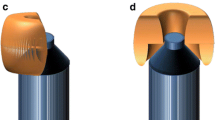Abstract
Biomonitoring is an important component of estuarine research and monitoring programs because living organisms integrate biological, chemical, and physical conditions over time. The deployment of biomonitoring devices in ecosystems that are subject to changes in water level and flow can be very challenging. This paper describes a new device, which facilitates such applications such as the deployment of periphytometers. The device is designed to encircle posts, poles, or pilings, such as channel markers common in many waterways. This device has been evaluated and approved for use by the US Coast Guard, needed for attachment to navigational aids. It allows attachment of monitoring devices requiring in situ deployment at fixed water depths in systems with dynamic water levels or velocities while minimizing the potential for shading, damage, theft, or poor long-term performance.
Similar content being viewed by others
References
American Public Health Association (APHA) (1998). Standard methods for the analysis of water and wastewater (20th Ed.). Washington: American Public Health Association.
Bricker, S. B., Clement, C. G., Pirhalla, D. E., Orlando, S. P., & Farrow, D. (1999). National estuarine eutrophication assessment: A summary of conditions, historical trends, and future outlook. Silver Spring: NOAA/NOS.
Florida Department of Environmental Protection (FL DEP) (1996). Standard operating procedures for biological assessment. Tallahassee: Florida Department of Environmental Protection, Biology Section.
Kennish, M. J. (2004). Estuarine research, monitoring, and resource protection. Boca Raton: CRC.
Kentucky Department of Environmental Protection (KDEP) (1993). Methods for assessing biological integrity of surface waters. Frankfort: Kentucky Department of Environmental Protection, Division of Water.
Lewis, M. A., Weber, D. A., Goodman, L. R., Stanley, R. S., Craven, G., et al. (2000). Periphyton and sediment bioassessment in North Florida Bay. Environmental Monitoring and Assessment, 65(3), 503–522.
Lewis, M. A., Weber, D. A., & Moore, J. C. (2002). An evaluation of the use of colonized periphyton as an indicator of wastewater impact in near-coastal areas of the Gulf of Mexico. Archives of Environmental Contamination and Toxicology, 43, 11–18.
Moss, J. A., Nocker, A., Lepo, J. E., & Snyder, R. A. (2006). Stability and change in estuarine biofilm bacterial community diversity. Applied and Environmental Microbiology, 72(9), 5679–5688.
Nocker, A., Lepo, J. E., & Snyder, R. A. (2004). Influence of an oyster reef on development of the microbial heterotrophic community of an estuarine biofilm. Applied and Environmental Microbiology, 70(11), 6834–6845.
Snyder, R. A., Lewis, M. A., Nocker, A., & Lepo, J. E. (2005). Microbial biofilms as integrative sensors of environmental quality. In S. A. Bortone (Ed.), Estuarine indicators. Boca Raton: CRC.
Stevenson, R. J., & Bahls, L. L. (1999). Periphyton protocols. In M. T. Barbour, J. Gerritsen, B. D. Snyder, & J. B. Stribling (Eds.), Rapid bioassessment protocols for use in streams and wadeable rivers: Periphyton, benthic macroinvertebrates and fish (2nd Edn). EPA 841-B-99-002. Washington: U.S. Environmental Protection Agency; Office of Water.
United States Code (2007a). Oceanographic research. Title 14, Part 1, Chapter 5, Section 94.
United States Code (2007b). Interference with aids to navigation penalty. Title 14, Part 1, Chapter 5, Section 84.
Author information
Authors and Affiliations
Corresponding author
Rights and permissions
About this article
Cite this article
Riley, L.W., Dix, N. & Phlips, E.J. A new attachment device for deployment of monitoring equipment in estuaries and other high-energy environments. Environ Monit Assess 173, 743–746 (2011). https://doi.org/10.1007/s10661-010-1419-2
Received:
Accepted:
Published:
Issue Date:
DOI: https://doi.org/10.1007/s10661-010-1419-2




